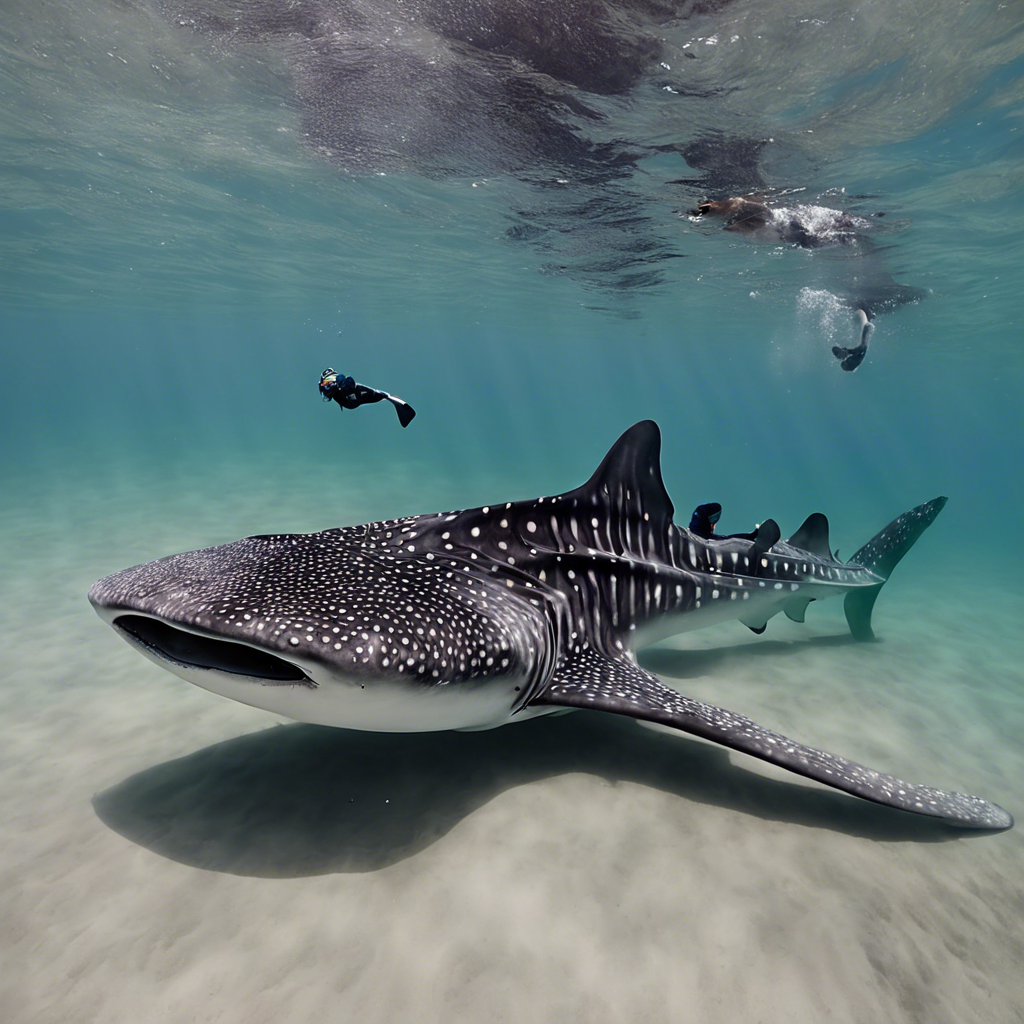Swimming with Whale Sharks in Mexico
Prepare to embark on an adventure of a lifetime. Just imagine yourself immersing in the warm turquoise waters, taking a deep breath, and plunging into a world where majestic whale sharks rule. The incredible experience of swimming alongside the world’s largest fish is both exhilarating and humbling. But how do we undertake this journey in a safe and sustainable manner? Fear not, for we are here to guide you into the deep, unveiling the beauty and magnificence of these gentle giants, while emphasizing the significance of conscious tourism. Be prepared to dive into an unforgettable swim with whale sharks experience.
“Traveling brings you face to face with your world. It’s not just about making memories, but also about becoming an active participant in this global ecosystem.”
In this comprehensive guide, we will delve into:
- Understanding the gentle giants: Whale Sharks
- Guidelines on how to safely swim with Whale Sharks
- Best times to plan your trip
- The role of tourism in Whale Shark conservation
- What to expect when swimming with these majestic creatures
Are you ready? Strap on your fins and let’s dive right in!
Unmasking the Gentle Giants: Understanding Whale Sharks
Clocked as the titans of the sea, whale sharks stir a sense of awe and reverence among lovers of the aquatic world. Known for their colossal size, these gentle-natured goliaths are, in fact, the world’s biggest fish, they can average between 5.5 meters (18 feet) and 10 meters (32.8 feet) in length. On rare occasions, some have even been known to reach a striking 14 meters (45.9 feet).
Don’t be fooled by the term ‘shark’ in their nomenclature–whale sharks bear more resemblance to whales, notably in their feeding behavior. They are filter feeders, gulping in enormous amounts of tiny marine creatures and plankton along with sea water, only to spit the water out through their gills. This makes them harmless to humans, perfect for your thrilling underwater adventure.
Whale sharks are not only intriguing for their mind-boggling dimensions and gentle disposition. They are migratory creatures, voyaging thousands of miles to reach their feeding and breeding sites, across the oceans. The longest recorded migration by a whale shark is an incredible 20,000 kilometers (around 12,430 miles)!
The skin of a whale shark is adorned with a unique and beautiful pattern of white spots and stripes, making each individual recognizable and distinctive. This fascinating skin pattern, much like the fingerprint in humans, is used by scientists for identification purposes, assisting in their ongoing conservation efforts.
Understanding these marvels of the marine world not only elevates our respect for them, but also ensures that we interact with them in a conscious, responsible manner during our thrilling underwater engagements.

How to Safely Swim with Whale Sharks
Now, let’s dive into specifics. No pun intended. Whale shark encounters can be adrenaline-rushing yet also tranquil, however, ensuring your safety and that of the shark is paramount. Following a few simple instructions can make sure your encounter is a memorable and ethically sound one.
Firstly, maintain a safe distance. Whale sharks are gentle creatures, but their size alone can accidentally lead to injuries. Experts recommend staying at least three meters away from the front of the animal and four meters from its tail.
Next, try to stay calm and composed. Splashing and rapid movements can startle the shark and disrupt their normal behaviour, ruining the experience for everyone. Remember, this isn’t just about you – it’s about respecting these magnificent creatures in their natural habitat.
Moreover, absolutely no touching is allowed. Whale sharks have a layer of protective mucus on their skin and touching them can disturb this layer, leading to possible infections. Let’s be clear – it’s not only for ethical reasons, but touching them could literally make them sick.
And finally, refrain from using flash photography. Bright lights can startle and disorient whale sharks. In fact, many tour operators prohibit the use of flash to protect the animals.
Remember, these steps are not only for ensuring your safety, but also to maintain an ethical interaction that respects the whale shark’s space. Keeping these guidelines in mind will ensure a thrilling and unforgettable encounter with these gentle giants of the deep.
Planning Your Trip: Best Times to Swim with Whale Sharks
Timing is everything when it comes to swimming with these magnificent marine creatures. Whale sharks, despite their colossal size, follow a seasonal pattern largely dictated by the marine food chain dynamics.
Most locations where this activity is available have a certain time of the year when the sighting of whale sharks is almost guaranteed. This typically coincides with plankton blooms or fish-spawning events, which are their main source of food. It’s no wonder they schedule their visits accordingly.
For instance, in Donsol, Philippines, the whale shark season runs from November to June, peaking between February and May. In Mexico’s Isla Holbox and Isla Mujeres, the best times stretch from June to September. If you’re considering going to Australia’s Ningaloo Reef, you might want to plan your visit between March and July. Always remember to check with local operators regarding these timings, as they can vary year by year.
Also, consider that early morning excursions often provide the calmest sea conditions and the best visibility, enhancing your chances to encounter and observe these graceful creatures.
Keep in mind, it’s never a wholesale guarantee that you will see whale sharks on any given day or month. However, by planning your visit during the peak season in your chosen destination, you have the best odds of diving into this unforgettable experience.
Before you set off on your underwater journey, remember to respect all rules and guidelines – they are there not only for your safety, but, importantly, for the wellbeing of the whale sharks too. Dive in, open your eyes wide, and let the awe-inspiring sight of the biggest fish in the ocean give you memories that will last a lifetime.

Be a Conscious Traveler: The Role of Tourism in Whale Shark Conservation
No conversation about interacting with the magnificent whale sharks can be complete without discussing the significant role of tourism in protecting these stunning creatures. As you embark on this fascinating journey, bear in mind that responsible tourism often plays a pivotal role in the survival and conservation of these beautiful marine animals.
Tourism is a double-edged sword — it can either contribute to the conservation of whale sharks, or it can cause damage to their natural habitat. For the former to happen, it’s crucial that you, as a tourist, understand and follow sustainable tourism practices.
The significant tourism revenue generated from the money you spend on your exhilarating swimming encounter with whale sharks often goes towards research and conservation efforts. This revenue also plays a role in providing jobs for local communities, therefore reinforcing the notion that living whale sharks have a higher value than hunting them for their meat and fins. This paradigm shift is important for whale shark survival.
However, irresponsible tourism can also lead to the disturbance of whale sharks’ natural behaviors and potentially even injuries to them. Whale sharks are exceptionally gentle and do not pose a threat to humans unless agitated, which can happen due to improper conduct in the water.
Therefore, it’s incredibly important to respect these creatures and their habitat while swimming with them. One way to do so is by following guidelines like keeping a safe distance, not touching or riding the sharks, and making sure not to use flash photography, which can disorient them. Every small action can help ensure that your encounter with them is as positive for the whale sharks as it is for you.
So, remember, when you choose to dive into the deep blue sea to swim with whale sharks, your journey is not just about the thrill of swimming alongside the largest fish in the world. It’s also about being a conscious traveler, playing your part in the conservation efforts of these amazing creatures. The thrill is times two — the exhilarating swim, and the knowledge that your journey contributes to the protection and understanding of these gentle giants of the ocean.
In the Heart of the Ocean: What to Expect When Swimming with Whale
Imagine this: You are floating in the all-encompassing blue, the palpable silence of the ocean surrounding you, interrupted only by your own heartbeat. Suddenly, in the distance, a colossal figure emerges from the abyss, its sheer size dwarfing everything in its proximity. This is the moment you’ve been waiting for. There’s a sense of utmost thrill coupled with a dash of fear, as the largest fish in the ocean—the whale shark—floats effortlessly towards you.
Your first encounter with the whale shark will leave you awestruck. It’s an overwhelming experience, yet filled with an indescribable semblance of peace. The whale shark may look intimidating due to its magnitude, but, remarkably, this gigantic creature is utterly gentle. Swimming alongside these underwater titans, you’ll soon realize they pose no threat, rather they infuse an unparalleled tranquility in the heart of their vast, aqueous home.
Interacting with these docile beings provides a fresh perspective on life, stripping back the fears and misunderstandings associated with sharks. Feel their unique skin, gaze into their small eyes, and witness the gracefulness of their glide; every second in proximity to these magnificent beings is a memory stitched into the fabric of your life.
Whale sharks are shy and considerate, they’ll never invade your personal space. They’d rather swim away if they feel threatened. Remember, it’s their home we are entering—respect is paramount.
There may also be a chance to observe their feeding behavior, a once-in-a-lifetime opportunity to witness the aquatic spectacle from a close vantage point.
As you swim alongside the whale shark, you’ll naturally find yourself pacing along with their tranquil speed, slowly adapting to their rhythm of life—an invaluable lesson reminding us to slow down and savor life’s minute details.
While it’s an exhilarating experience, remember to strictly adhere to the guidelines for whale shark interaction. Your adventure should not distress or cause harm to these marine giants. Indeed, the experience transcends the thrill of the moment—it’s about cultivating respect for these majestic, misunderstood animals and the world we share with them.
Conclusion
Swimming with whale sharks is undeniably an adventure of a lifetime. To be immersed in the tranquil beauty of the ocean while beholding such magnificent creatures, observably, leaves an indelible imprint on your soul. But remember, it’s not enough just to be a passive observer in this experience. You are an active participant in the story of these majestic marine beings. Respect them, appreciate their presence, and strive to protect their environment. This goes beyond the time you spend in the water—it reflects in your choices, your actions, and your words.
The exhilaration of swimming alongside the world’s largest fish is, undoubtedly, a thrilling encounter. Yet, it calls for us, as travelers and lovers of the natural world, to be mindful of our impact. To engage in this activity responsibly, means to ensure we’re not harming these marine giants or detracting from their natural way of life.
Aiming for this, not only does your experience become a bucket list moment in your life, but it also contributes to the betterment of the marine ecosystem. Now, more than ever, whale sharks need our protection and respect. And, by choosing to swim with them in a safe and sustainable manner, you’re also choosing to uphold that responsibility.
So the next time you step into the vast blue, remember your part in this grand ocean narrative. Remember that every splash you make, every stroke you take, is a part of this bigger picture. And that, dear reader, is the true beauty of swimming with whale sharks.







